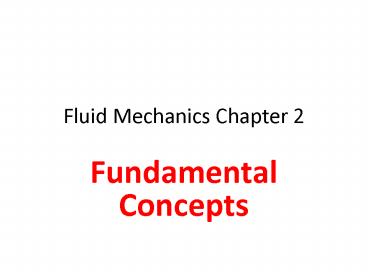Fluid Mechanics Chapter 2 Part I - PowerPoint PPT Presentation
Title:
Fluid Mechanics Chapter 2 Part I
Description:
Lecture s – PowerPoint PPT presentation
Number of Views:623
Title: Fluid Mechanics Chapter 2 Part I
1
Fluid Mechanics Chapter 2
- Fundamental Concepts
2
Fluid as a Continuum
- The region of space in which a fluid properties
such as density could be treated as continuous is
called continuum. - In a continuum each fluid property is expected to
have a definite value at every point in space - So fluid properties of density, temperature and
velocity and so on are considered continuous
function of time in a continuum
3
Some basics
- So in a continuum, density of a fluid will be
- Specific gravity is a measure of how dense a
fluid is with reference to water - So Mercury is 13.6 times denser than water with a
specific gravity of 13.0 - Specific gravity decreases with increase in TEMP
4
Some basics
- Specific weight of a substance is weight per unit
volume
5
Velocity Field
- A very important property defined by a field is
the velocity field, given by - Velocity is a vector quantity, requiring a
magnitude and direction for a complete
description, so the velocity field is a vector
field. - velocity vector, also can be written in terms of
its three scalar components - Velocity field means it is the velocity of a
fluid passing through a point in space with
coordinates X,Y,Z at time instant t. - U,V,W are the components of velocity in X , Y and
Z directions
6
Basics
- Steady Flow If properties at any point in a
fluid flow donot change with time, it is called a
steady flow. Mathematically for any property - So it could be
7
Steady Flow
- In a steady flow the fluid properties may vary
from point to point in the field but would remain
constant at that point with respect to time
8
One-, Two-, and Three-Dimensional Flows
- A flow is classified as one-, two-, or
three-dimensional depending on the number of
space coordinates required to specify the
velocity field - velocity field may be a function of three space
coordinates and time. - Such a flow field is termed three-dimensional
9
Uniform Flow
- A Flow in which Velocity is constant at any cross
section of flow is called a uniform flow - Under this assumption a 2 dimensional flow is
modeled as one dimensional for analysis. - The density and pressure may also be assumed
constant in the cross section of a uniform flow
10
Uniform flow field
- A flow field in which velocity is constant and
independent of all space coordinates in the
entire flow field
11
Timelines , pathlines, streaklines and streamlines
- Pathline It is the path or trajectory of a
moving fluid particle. To identify this a dye
/colour may be added to the fluid and photographs
taken for the particle throughout its motion. - Streakline If we focus our attention on a fixed
location. And identify All the particles which
passed through this location at different draw a
line joining all these particles, the line so
drawn will be called streakline - StreamlinesLines drawn in a flow field so that
at a given instant they are tangent to the flow
direction are called streamlines - Timelines A line marked in a flow and
visualising it how it changes over a period of
time
12
Timelines , pathlines, streaklines and streamlines
13
Conclusions
- Steady Flow Streamlines, streaklines and path
lines are the same(identical). - Unsteady flow All these lines are different
14
Mathematically deriving streamlines and pathlines
- Streamlines
- Pathline A simulataneous solution of following
equations give path line in
15
Mathematically deriving streamlines and pathlines
- Streaklines First derive the path lines and the
apply following formulas
16
(No Transcript)
17
(No Transcript)
18
(No Transcript)
19
(No Transcript)
20
(No Transcript)
21
End of Part I of the Chapter































